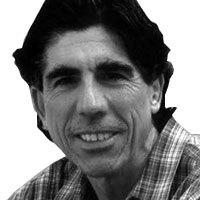Julia Le Duc’s photo of a drowned migrant father and his 23-month-old daughter lying face down on the bank of the Rio Grande after trying to cross into the United States doesn’t have a title and may never get one. But Le Duc’s photo, which shows the daughter tucked inside her father’s shirt, is already informing the debate over the Trump administration’s harsh immigration policies.
The Trump administration has done its best to make sure photographs are not taken inside immigration detention centers, and the last thing it wanted was a photo as revealing as Le Duc’s.
Senate Minority Leader Charles Schumer (D-NY) displayed a blown-up version of Le Duc’s photo on the Senate floor when he challenged President Trump to change his immigration policy. “President Trump, I want you to look at this photo,” Schumer declared. “These are not drug dealers or vagrants or criminals; they are simply people fleeing a horrible situation.”
Le Duc’s photo belongs to a documentary tradition that has its modern roots in the iconic photographs Margaret Bourke-White took of the liberated Nazi concentration camp Buchenwald for the May 7, 1945, issue of Life magazine. “Dead men will have indeed died in vain if live men refuse to look at them,” is the telling caption Life used for Bourke-White’s pictures.
For Le Duc, as it was for Bourke-White, the challenge as a photographer is making sure people previously written off as faceless—refugees, survivors, immigrants—are seen as individuals. What still photos like Le Duc’s and Bourke-White’s do that television does not is create a calm moment in which viewers can think about a single image and the back story it evokes.
“I was drawn to the girl’s arm on her father,” Le Duc, a photojournalist for the Mexican newspaper La Jornada, said in an interview published the day after her picture gained world-wide circulation. “It was something that moved me in the extreme because it reflects that until her last breath, she was joined to him not only by the shirt but also in that embrace in which they passed together into death.”

Le Duc’s empathy with the father, Oscar Alberto Martinez Ramirez, and his daughter Valeria goes to the heart of what actually happened. Over the weekend the Salvadorian family tried to apply for asylum at the international bridge in Matamoros, Mexico, but they found the offices closed and many waiting ahead of them. Their best alternative, they concluded, was to try to cross the Rio Grande where it seemed swimmable.
On their first try father and daughter made it. Martinez then went to help his wife get across, but Valeria, not understanding that her father would be coming back, jumped in the Rio Grande after him. An exhausted Martinez now had to go back for his daughter, and at this point the Rio Grande’s current proved too much for him.
Le Duc’s photo has been compared to the 2015 photo by Nilufer Demir of Alan Kurdi, a Syrian Kurdish boy who was discovered washed up on a beach in Turkey after a tragic attempt by him and his family to get to Europe and from there to relatives in Canada. “It is our version of the Syrian photograph—of the three-year-old boy on the beach, dead. That’s what it is,” Texas Democratic Congressman Joaquin Castro has charged.

It was like a “children’s graveyard,” Demir, who at the time was working for Turkey’s Dogan News Agency, later observed of the scene that she had photographed. In her refusal to distance herself from the death of Alan Kurdi, Demir, like Le Duc, showed an engagement that is intensely personal.
How intense such engagement can get was reflected during the Vietnam War with the taking of the photos that let the public see what happened at the My Lai massacre of March 16, 1968, when American troops killed hundreds of unarmed villagers in the hamlet of My Lai.
The military did what it could to hush up the massacre, which was brought to light by the freelance journalist Seymour Hersh, but it was the photographs of the massacre that finally made it impossible for the military and the Nixon administration to deny what had happened at My Lai.
The photographs of My Lai that the public saw were taken by Army combat photographer Ron Haeberle with his own camera, and in 1969, following his honorable discharge from the Army, Haeberle sold the photographs to his hometown paper, the Cleveland Plain Dealer, and subsequently to Life magazine.

“I kept thinking, ‘This is not right,’” Haeberle would say of a massacre that he as an Army photographer had witnessed but had been unable to stop. As a civilian Haeberle had a chance to achieve with his photos a measure of the justice he had been powerless to bring about as a soldier, and he did not hesitate to act.
How much more attention will Le Duc’s photo gain in the coming weeks? The answer will depend on the use the Trump administration makes of the $4.6 billion humanitarian-aid bill that Congress has just passed to help deal with the immigration crisis on our southern border.
We are at this point a long way from a decade like the ’30s, when the Roosevelt administration made a point of hiring, among other photographers, Dorothea Lange—soon to be known for her “Migrant Mother” portrait—because the administration wanted a visual record of its efforts to alleviate rural poverty. These days the photographers Le Duc’s work puts her closest to are, more often than not, in conflict with governments.








